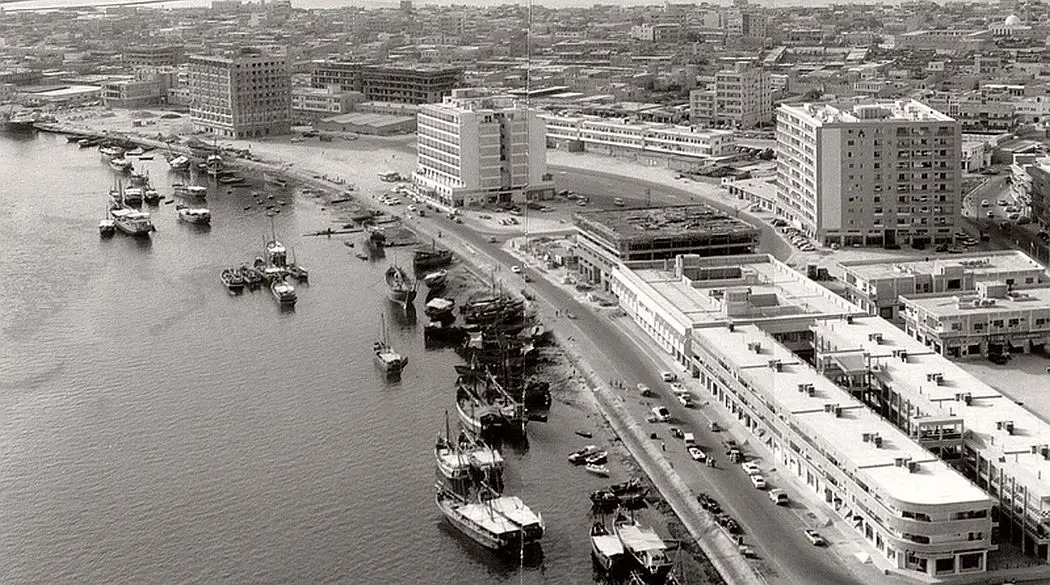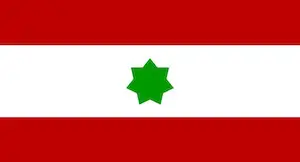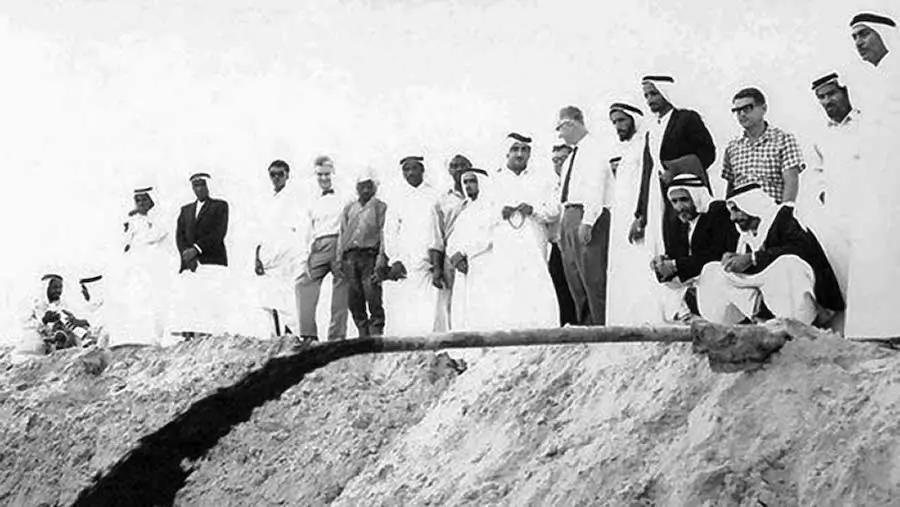1059 - 1966: Before the discovery of oil
1095 - 1580: First mentions of Dubai
The earliest mention of Dubai was recorded in 1095 in The Book of Geography, written by the Andalusian-Arab geographer Abu Abdullah Al Bakri. But more recent mentions start in 1580 from the Venetian pearl merchant Gaspero Balbi. Balbi recorded the city of Dubai when he visited for their pearl trade. At the time, Dubai was a simple port city and relied solely on fishing, boat-building and the pearl trade to fund peoples livelihood. Dubai also relied on building accommodation for traders who would pass through to sell gold, textiles and spices at the markets.
1750's - 1949: The Pearling Industry
In the 1750s, pearling became the main industry of the Gulf, including Dubai, and this continued well into the twentieth century despite it being a seasonal trade. The pearling season, known in Arabic as Ghaus al-Kabir (the great dive), lasted between May and September of each year. Men from around the Gulf and further afield would gather at the Gulf ports (Dubai, Abu Dhabi and Ras al-Khaimah in particular), ready for a three and a half month expedition. Fleets of up to 1200 boats would set sail on these expeditions from the ports. It was even recorded in Lorimer’s Gazetteer that 22,000 men (accounting for more than 50% the population of the then Trucial States) were employed for pearling season by the 1900s. The success of the pearling industry was mainly due to the rise in demand for pearls in the West, combined with their rising interest in the Orient. The pearling industry transformed Dubai into one of the leading ports in the Gulf.

Despite the fluctuation of pearl pricings throughout the time of the pearling industry, success was still booming. But this all came to a crashing halt by the 1930s, when the creation of the artificial pearl started to take off in Japan. Although the technique for creating (not very rounded) artificial pearls can be traced back to thirteenth century China, the first batch of rounded artificial pearls was made in 1900 in Australia, by a man called William Saville-Kent. Two Japanese men, Tatsuhei Mise and Tokishi Nishikawa, learned of this technique from the Australian and brought it back to Japan. However, the start of the artificial pearl business didn’t truly pick up until a man called Kokichi Mikimoto, born in Japan in 1858, started to conduct his own experiments on making artificial pearls after being in the pearl-selling business during his twenties. He would remain unsuccessful for five years until he learned of the technique that Tatsuhei and Tokishi had brought back from Australia. His own pearls, coined the “Mikimoto Pearls”, became a huge success in the European markets, selling at 25% less than the price of natural pearls. So by the 1930s, the artificial pearls were now matching - and exceeding - the Gulf’s natural pearls in both price and quality (to the untrained eye).
This was a disaster for the Gulf pearling industry. By 1927, pearling merchants began struggling with high interest and borrowing rates. The Great Depression in 1929 further reduced demand for natural pearls and by 1931, the price of natural pearls had dropped by 75% in just two years. The final blow on the industry came in the form of tax imports from the Indian government on pearl imports from the Gulf. The very last pearling fleet set out from Dubai in 1949.
1778 - 1853: Bani Yas, Al Qassimi and the Trucial States
It is hard to talk about the history of Dubai without also mentioning Abu Dhabi, Dubai's neighbouring emirate and the founding Bani Yas tribe. Originally, the Bani Yas tribe came from Abu Dhabi. There is a legend that surrounds the name of Bani Yas. A leader (or more commonly, sheikh), called Yas, dug the first well in the oasis in Abu Dhabi, led by a Gazelle (this is where the name Abu Dhabi comes from - Father of the Gazelle) and several tribes congregated around this well, leading to the name Bani Yas. However, it is more likely that the name derived from a man called Yas Bin Amer, who was a tribal leader with a lineage that dates far back.
The Bani Yas tribe are a big part in the formation of Dubai as we know it today. Abu Dhabi and Dubai used to be at war in the past over their borders. In 1833, Maktoum bin Butti of the Bani Yas tribe decided to settle in the Dubai Creek and declare independence of Dubai from Abu Dhabi. From then on, Dubai was declared a fishing village (alongside being a pearling port). This was the start of putting Dubai on the map, figuratively, and also the start of the ruling Maktoum family of Dubai.
There was another tribe called the Al Qassimi tribe, among several other tribes that existed before the founding of the UAE. Dating back from before the independence of Dubai from Abu Dhabi, Al Qassimi were responsible for several maritime skirmishes with the British, starting in 1778. This led to great instability along the Gulf coast on the Arabian side. After several years of maritime wars between the British and the tribes, including both Al Qassimi and Bani Yas>, the British finally won in 1819 and began to destroy any buildings that were Qassimi owned, flying the British flag. Because of their win, sheikhs of several tribes started to surrender to the British.
In January 1820, over a period of 10 days, Sheikhs from the tribes began to sign peace treaties with the British. This involved giving up their strongholds, guns and vessels in exchange for the British sparing their towns, or then known sheikhdoms. The first six Sheikhdoms (Abu Dhabi, Dubai, Ras al Khaimah, Sharjah, Ajman and Umm al Quwain), after signing the General Maritime Treaty of 1820, formed what was known then as the Trucial States (with Fujairah to join in 1952). This is what would be the start of the modern day United Arab Emirates.

The maritime warfare didn’t stop there. Attacks on British ships by the Bani Yas tribe in 1835 then led to a maritime truce, banning any maritime warfare during the Gulf coast’s pearling season. This then finally led to a permanent maritime warfare ban in 1853, in return for British protection. This made the Trucial States British protectorates. The Sheikhs were presented with a final General Treaty of Peace which would stop piracy along the Gulf coast, and all of the Trucial states had to fly a red flag with a white border. OVer time, each state had developed their own version of the flag to fly.
1909-1966: The Discovery of Oil
By keeping on good terms with the British, the sheikhdom of Dubai continued to survive and thrive under the Al Maktoum dynasty, which is still the leading dynasty today. After the end of the pearling industry, Dubai became a business port instead. As the pearling industry was on its final leg, many oil companies were set up and had bought concessions to start exploring the Gulf banks for oil. This is despite the fact that originally, they had been told that there were no prospects of finding any. Still, with a small bit of hope, the searching began.
Starting in the early 1930’s, the exploration of oil was put on hold due to the start of World War II, and continued to be delayed even after the end of the war in 1945. Searches for oil in Dubai (and Abu Dhabi) didn’t start up again until 1953, when the company Anglo-Iranian (soon to be known as British Petroleum) instructed their subsidiary, the D’Arcy Exploration Company, to apply for a concession to search for oil off the coast of Abu Dhabi. This concession was granted on the 9th March 1953.
Prospects were looking bleak until 1966 when finally, oil was struck in the Fateh (meaning Good Fortune in english) oil field, 75 miles / 120 km east off the coast of Dubai. By the 1970’s, three twenty-story submarine tanks had been built in the seabed, carrying these oil reserves, and were given the name “The Three Pyramids of Dubai”. After the discovery of oil, the late Sheikh Rashid bin Saeed Al Maktoum began the development of Dubai, transforming it into the modern port city it is today.
